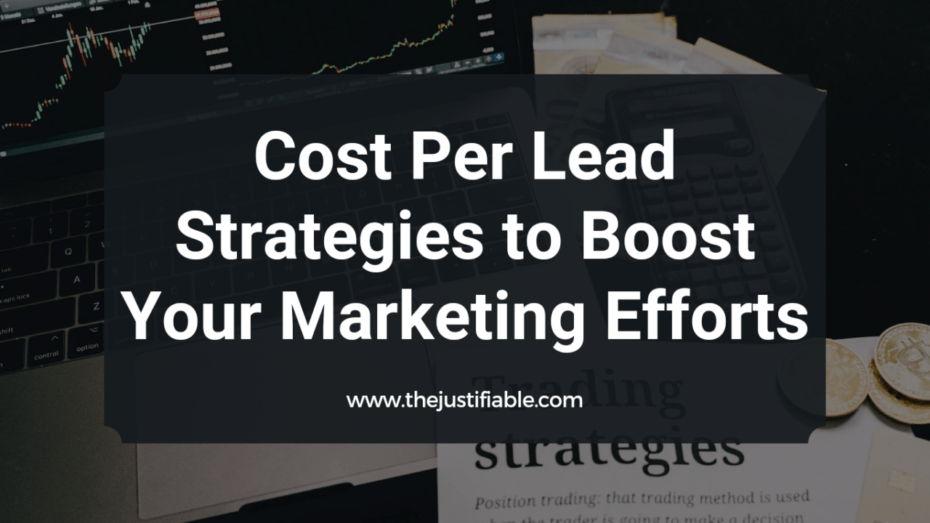Table of Contents
Cost Per Lead Strategies to Boost Your Marketing Efforts!
Marketing strategies can be complex and varied, each with its specific goals and metrics for success. One such key metric is Cost Per Lead (CPL), a significant indicator of both the efficiency and effectiveness of your marketing efforts.
By truly understanding and effectively managing your CPL, you can significantly boost your marketing performance.
Understanding Cost Per Lead (CPL)
Diving into the intricacies of marketing strategies, let’s start by unraveling the concept of Cost Per Lead.
What is Cost Per Lead?
Cost Per Lead, commonly abbreviated as CPL, is a digital marketing metric that measures the total cost your business incurs to acquire a new lead. In simpler terms, it represents how much you’re spending to get potential customers interested in your product or service.
To put it in perspective, imagine running an online advertisement campaign where you spend $500 and as a result, you acquire 100 leads. In this scenario, your CPL would be $5, indicating that you’re spending $5 to get each new potential customer.
Importance of Calculating Your CPL
The significance of calculating your CPL cannot be overstated. It serves as a critical gauge to determine the financial success of your marketing campaigns.
By understanding your CPL, you can evaluate the cost-effectiveness of different marketing channels and campaigns, and allocate your marketing budget more efficiently. Moreover, it helps in forecasting future marketing expenses and estimating the number of leads you can generate within a certain budget.
A low CPL could signify a highly effective campaign, or it could indicate low quality leads. Conversely, a high CPL might point to an expensive campaign, or it could mean you’re generating highly qualified leads. Therefore, interpreting CPL requires context and should always be considered alongside other key performance indicators such as lead quality and conversion rates.
How to Calculate Cost Per Lead
Calculating CPL is straightforward. You simply divide the total amount spent on a marketing campaign by the number of leads generated from that campaign.
For instance, if you spend $2000 on a marketing campaign and generate 200 leads, your CPL would be $2000 divided by 200, which equals $10. This means that for every $10 you spent on this specific campaign, you obtained a new lead.
Remember that different campaigns will have different CPLs. Comparing these can give you insights into which marketing efforts are most cost-effective for lead generation, helping guide future marketing decisions.
Key Factors Impacting Cost Per Lead
Cost per lead is influenced by a multitude of factors, each playing a vital role in the final figure. To optimize your marketing efforts and achieve a desirable CPL, you need to understand these factors and how they interact with one another.
Here, we focus on four crucial elements: industry type and market saturation, target audience and demographics, quality of leads, and marketing channels used.
Industry Type and Market Saturation
Your business’s industry type and the saturation of the market within that industry significantly impact your cost per lead. Highly competitive industries, such as finance or insurance, tend to have higher CPLs due to increased advertising costs and lower conversion rates. On the other hand, industries with less competition may enjoy lower CPLs.
Market saturation, the extent to which your potential market has been penetrated, also affects CPL. In oversaturated markets, CPL is typically higher due to the greater effort required to attract the attention of potential customers. However, untapped or undersaturated markets may offer lower CPLs and greater opportunities for expansion.
Target Audience and Demographics
Another critical factor impacting CPL is the specific audience you’re targeting and their demographic details. Age, income, education, gender, and geographic location, among other characteristics, play a substantial role in defining your cost per lead.
For example, younger audiences might be easier to reach via social media platforms, possibly leading to a lower CPL. Conversely, an older, more affluent demographic may require more traditional, and often costlier, marketing channels. Thus, understanding your target audience and choosing the most effective way to reach them can significantly influence your CPL.
Quality of Leads
The quality of the leads you’re pursuing can also significantly affect your CPL. High-quality leads, those more likely to convert into customers, usually cost more to acquire. This is because they often require highly targeted, personalized marketing efforts to engage them effectively.
However, it’s essential to balance the cost of acquiring high-quality leads with their potential long-term value. A high CPL may be acceptable, even beneficial, if those leads are likely to become loyal, high-spending customers. Conversely, pursuing lower-quality leads may reduce your CPL but could result in lower conversion rates and customer lifetime value (CLTV).
Marketing Channels Used
The choice of marketing channels also plays a significant role in determining your CPL. Each channel, be it email marketing, social media, search engine marketing, or content marketing, comes with its own costs and lead generation capabilities.
Some channels might offer a low CPL but generate less qualified leads. Others might be more expensive but bring in high-quality leads. Therefore, selecting the right mix of marketing channels is essential to balance the quantity and quality of leads, ultimately optimizing your CPL.
Effective Cost Per Lead Strategies to Boost Your Marketing Efforts
Understanding the factors that impact your CPL is just the beginning. The real game-changer lies in implementing effective strategies that directly address these factors.
This section explores four powerful strategies that can help lower your cost per lead and enhance the success of your marketing efforts.
Optimizing Landing Pages for Lower CPL
A landing page is often the first interaction potential customers have with your business, making it a critical component in determining your CPL. Optimizing these pages can drastically reduce your CPL by increasing conversion rates.
Firstly, your landing page should have a clear and compelling value proposition that communicates why your product or service is worth the prospect’s time and attention. Next, an attention-grabbing call-to-action (CTA) encourages potential leads to take the desired action, improving conversion rates.
Simplifying the form filling process, personalizing content, and ensuring your landing page is mobile-friendly can also play vital roles in enhancing user experience and lead conversion, subsequently lowering CPL.
A/B Testing and Its Impact on CPL
A/B testing, also known as split testing, is a method of comparing two versions of a webpage or other marketing asset to see which performs better. It’s a crucial tool for marketers looking to lower their CPL.
By testing different elements of your marketing campaigns, such as headlines, content, images, CTAs, or even landing page designs, you can understand what resonates most with your audience. This insight allows you to optimize your efforts, improve lead generation, and ultimately, decrease your CPL. Remember, even small changes can sometimes lead to significant improvements.
Content Marketing to Lower CPL
Content marketing is another potent strategy to lower your CPL. By providing valuable, high-quality content, you can attract and engage potential leads organically, often at a lower cost than other marketing methods.
Blogs, eBooks, webinars, podcasts, and infographics are just a few types of content that can help draw in potential customers. SEO-optimized content can boost your visibility on search engines, driving more organic traffic to your site, and increasing the potential for lead generation.
Remember, content marketing is not just about quantity but quality. High-quality content can position your brand as a thought leader, build trust with your audience, and cultivate more qualified leads, all contributing to a lower CPL.
Utilizing Social Media for Lower CPL
In the digital age, social media platforms provide a cost-effective channel for lead generation. They allow businesses to target specific demographics, ensuring your marketing efforts reach those most likely to be interested in your product or service.
Platforms like Facebook, LinkedIn, and Instagram offer advanced targeting options, including age, location, interests, and behaviors. With compelling content and strategic use of these platforms, you can generate more leads for less, significantly reducing your CPL. Keep in mind that each platform has its own best practices and audience expectations, so tailor your approach to each one for the best results.
Evaluating Your Cost Per Lead Performance
An integral part of any marketing strategy is consistent evaluation and adjustment. With respect to cost per lead, this involves tracking your CPL over time, understanding its connection to return on investment (ROI), and benchmarking your CPL against industry standards.
Tracking Your CPL Over Time
Monitoring your cost per lead over time is essential for a clear view of your marketing efforts’ effectiveness. This isn’t a one-time calculation; instead, you should track it consistently across different campaigns and periods.
When you track your CPL over time, you can spot trends and patterns. For instance, you might notice seasonal fluctuations in your CPL, with higher costs during peak business periods. By identifying these trends, you can adjust your marketing strategy and budget allocation accordingly.
Furthermore, tracking CPL across different campaigns enables you to compare their effectiveness and determine which strategies work best for your business. This continuous evaluation aids in refining your marketing strategy for optimal results.
CPL and ROI: Making the Connection
Cost per lead and return on investment (ROI) are intimately linked. ROI measures the profitability of your investments, in this case, your marketing efforts. The lower your CPL, the less you spend to acquire each lead, and if these leads convert at a high rate, your ROI increases.
However, a balance must be maintained. As discussed earlier, a lower CPL might result in lower quality leads, which could decrease your conversion rate and overall ROI. Therefore, it’s crucial to find the sweet spot where you get the highest quality leads at an acceptable CPL to maximize ROI.
Understanding this connection between CPL and ROI allows for more informed marketing decisions, ensuring that your strategies not only lower CPL but also contribute to a healthier bottom line.
Benchmarking Your CPL Against Industry Standards
Lastly, while it’s essential to track and improve your CPL, you also need to know how you stack up against others in your industry. Benchmarking your CPL against industry standards can provide a valuable perspective on your performance.
These standards can be found through industry reports, benchmarking tools, or professional networks. If your CPL is significantly higher than the industry average, it might indicate that your marketing efforts are less effective and need optimization.
Conversely, a CPL much lower than the average might suggest that you’re doing well, or it could point to a potential issue, like targeting low-quality leads. In any case, understanding where you stand can provide valuable insights and help shape your marketing strategies.
Next Steps in Refining Your Cost Per Lead Strategy
Successful marketing involves continuous refinement of strategies, especially when it comes to optimizing your cost per lead. Your next steps should focus on ongoing analysis and adaptation, leveraging effective tools for CPL management, and staying up-to-date with future predictions and trends in CPL.
Ongoing Analysis and Adaptation
Refining your CPL strategy requires a commitment to ongoing analysis. By consistently evaluating your campaigns, tracking changes in CPL, and identifying successful elements, you can continually refine your approach.
Keep in mind that marketing is not static. Factors like changes in customer behavior, market trends, or the competitive landscape can influence your CPL. Therefore, be prepared to adapt your strategy based on your analysis. Be agile, test new tactics, and scale the strategies that deliver the best results.
Leveraging CRM Tools for Effective CPL Management
In this digital age, numerous tools can simplify and enhance your CPL management. Customer Relationship Management (CRM) systems are particularly effective. They can track leads through the sales funnel, providing valuable insights into lead behavior and the effectiveness of your marketing efforts.
CRM tools can help automate the process of calculating your CPL, providing real-time insights and freeing up resources for other marketing tasks. They also offer valuable segmentation capabilities, allowing you to calculate CPL for different demographics, products, or campaigns.
Leveraging these tools can streamline your processes, improve accuracy, and provide the insights you need to lower your CPL effectively.
The Future of CPL: Predictions and Trends to Watch
Finally, keep an eye on the future. The marketing landscape is ever-evolving, and staying ahead of the curve can provide a competitive edge.
Predictive analytics is one trend to watch. With advancements in artificial intelligence and machine learning, predictive tools are becoming more accurate and accessible. These tools can forecast future CPL based on historical data, helping you plan more effectively.
Also, expect a continued emphasis on lead quality. More businesses are recognizing that a low CPL isn’t beneficial if those leads don’t convert. So, strategies focusing on attracting high-quality leads, even at a slightly higher CPL, are likely to be more prevalent.






